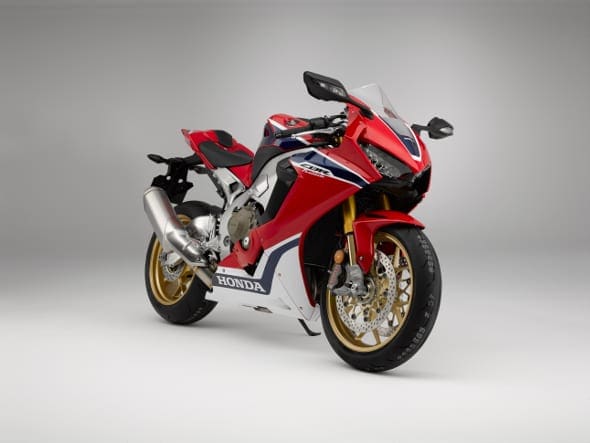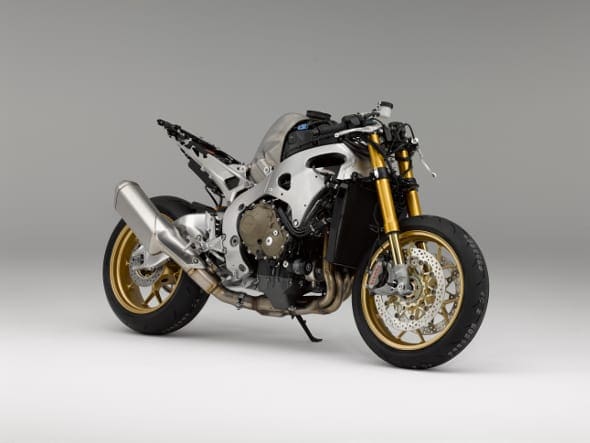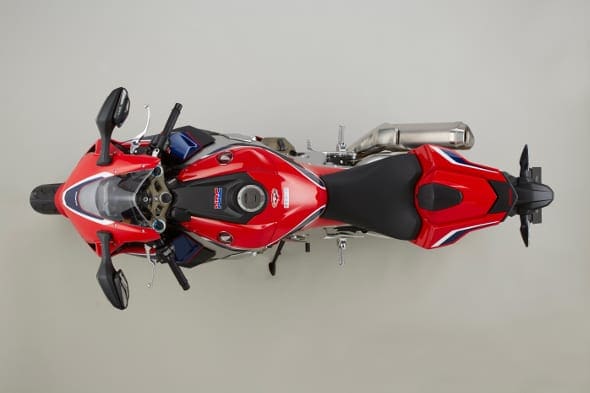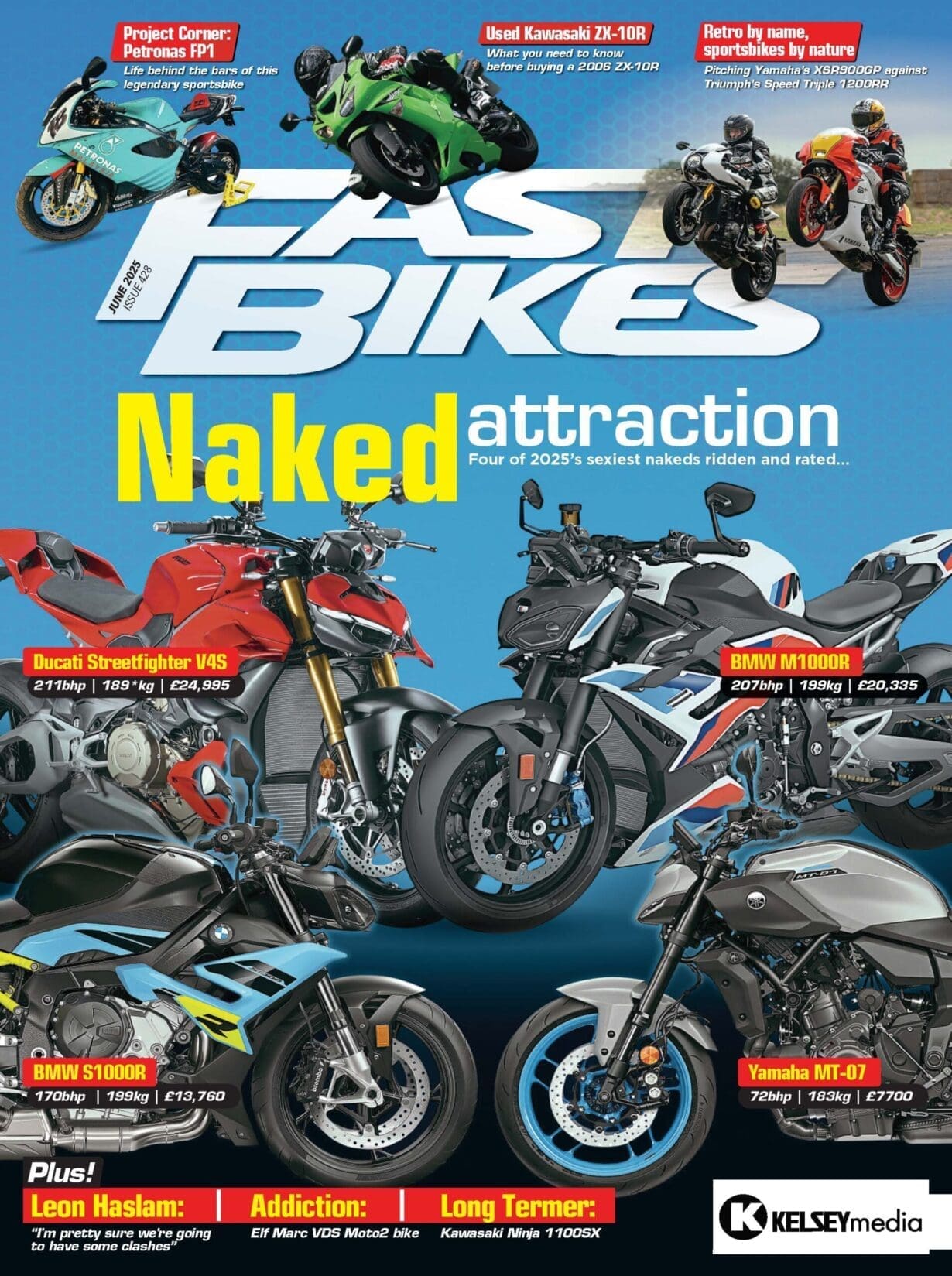Honda releases first details of revamped Fireblade – now available in three flavours including this first-to-be-released SP1 version. This really is just what the doctor ordered. We all know how ridable the current bike is – just look at the bike’s TT results – and with a slashing of weight and an upping of power the bike can only be better. Add the array of electronics and Honda is back in the game. We’re expecting a slightly simpler base model and a seriously impressive SP2 model, but the SP1’s specs already sound seriously sexy. It’s been a long time coming, but finally Honda is back in the game.

With a power to weight ratio boost of 14 per cent (via a 14kg weight reduction and 11bhp power hike), the introduction of electronics was inevitable. Ride-by-wire and a five-axis Inertial Measurement Unit (IMU) is the key to the new bike’s electronics, this in turn controlling the nine level Honda Selectable Torque System (aka traction control with a wheelie control function), cornering ABS and Rear Lift Control. The Fireblade gets a quickshifter as standard, with a downshift assist system giving the slipper clutch a hand when required. Semi-active Ohlins suspension is also added for good measure, controlled through the Suspension Control Unit. Yup, Honda has gone to town here!

Here’s a flavour of what’s in store for anyone lucky enough to have one on order for delivery early next year.
Engine
The power boost comes complements of the core of the old bike, with the current bike’s architecture remaining so we’re still looking at a 999.8cc block, albeit with every component coming under the Honda microscope. Two kilos has been lost around the motor, and this has allowed the rev ceiling to creep up to 13,000rpm. New pistons, different crank construction, changed valve lift, revised cam timing, new magnesium alloy engine covers and a new titanium exhaust all go towards the upped output of 189bhp at the crank.
Suspension
Honda has splashed out on quality Ohlins units – a NIX30 fork and TTX36 shock. These are found on the current SP model, but now the Fireblade SP1 gets the S-EC semi-active suspension system. Being told what to do by the 40 gram Bosch MM5.10 IMU and one of the six riding modes (three active – track, sport and comfort – and three manual controlled), the suspension offers control and craft over a variety of surfaces. Bore and stroke remain constant, but compression is increased from 12.3:1 to 13:1 thanks to a new crown design on the piston, which also boasts new wall thicknesses. Valve lift and cam timing utilise the new components better to increase the bike’s power output. Tadeo Baba would be proud of the weight loss story of the engine, with the switch to a lithium-ion battery, magnesium engine covers and narrower radiator (100grams lighter) all contributing to the 2 kilo loss (half of which comes from the battery). All the transmission gears have been lightened. The new titanium 4-2-1 exhaust loses nearly three kilos while is close to the current position to optimise the bike’s centre of gravity. Honda has also upped the throttle body size from 46mm to 48mm.
Frame and Swingarm
Adjusted rigidity is the big story with the chassis, with no huge changes visible. Thinner walls knock half a kilo off the frame’s weight with it tuned to offer 10 per cent more flexibility on the torsional plane while retaining transverse rigidity – all helping the HESD electronic steering damper to do less work. There’s a new swingarm and subframe, knocking nearly a kilo off the current units. The us of titanium to construct the fuel tank is impressive, offering a 1.3kg weight saving over steel.

Wheels
100 grams of unsprung weight is lost from the new five-spoke Y design. Honda shoe on a 120/70 front and a 190/50 rear tyre.
Brakes
Brembo monoblocks are used on the SP1 with a new formulation of brake pad. Out goes the massively heavy C-ABS system and in comes the system integrated into the Bosch IMU. Rear Lift Control is included alongside the impressive Cornering ABS system that works with trail braking by using wheel speed, slip rates and lean angle to vary the threshold for ABS decompression.
Fairing
The fairing is the recipient of tweaks, and is thus 24mm narrower up top, 18mm in the middle and 15mm thinner around your knees.
Slipper clutch and Downshifter
The slipper clutch is all new, using a die-cast pressure plate and clutch centre for a lighter feel at the lever. Aluminium cams replace steel units, while the gap between accelerating and decelerating cams has changed to aid rider use. The three level Downshift Assist works on injection cuts and ignition retard and also features an auto-blipper.
Acceleration Position Sensor
This is what Honda calls the ride-by-wire system, and this allows three power modes to be selected – the Riding Mode Select System. The HSTC system has been pilfered from the RC213V-S, and uses wheel speed sensors and machine roll angle to reduce the throttle position. Nine levels of the Torque Control are offered, plus it can also be turned off. Three levels of Selectable Engine Brake (SEB) are also available.





